pulpmil2
[WGN 45-0-04]
July 11, 2002 - Work on the Middlebury/Weybridge Pulp Mill Bridge Continues.
With a start date of June 10, the span is scheduled to reopen August 9.
The old "double-barrel" bridge stands in a tight little
urban neighborhood. Its importance to the neighborhood and the larger community becomes
evident when the bridge is closed--the towns usual traffic patterns are disrupted as bridge users
crowd alternate routes.
The Pulp Mill is the only two-lane covered bridge in
Vermont that carries regular daily traffic. Vermont s other two-laner originally served Cambridge.
It now stands next to Route 7 in Shelburne and is used as an entry for staff at the Shelburne
Museum. This tally does not count Windsor's two-laner over the Connecticut River, because 99%
of it is in New Hampshire.
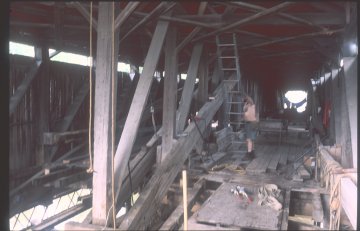
|
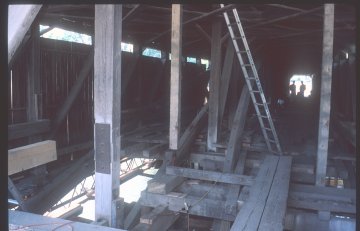
|
| Work continues on the middle truss of the west span, rebuilding
the chord, staggering joints, adding shear blocks, shouldering, and check braces. |
As work progresses on the middle truss of the "double-barrel bridge," the roadway is
taken up to gain access to the middle chord. Access is incidentally gained to the outside truss
chords also in need of work. However, funds and the contract cover only the middle truss. |
According to Mr. Lewandoski, when the Pulp Mill bridge was constructed, the builders overlooked several key details. The posts, which receive heavy braces, don't shoulder within the chords. That is, the notched posts aren't fitted into lower chord members notched to receive them, latching them in place. Instead, the bottoms of the posts are reduced in thickness to fit between the chord members and held there with a single bolt. The tremendous load of the nearly two-hundred- foot-long span transmitted through the braces set at the bottoms of the posts would break the posts, sliding them between the chord members. The bridge started failing right away, and carpenters have been fixing it ever since.
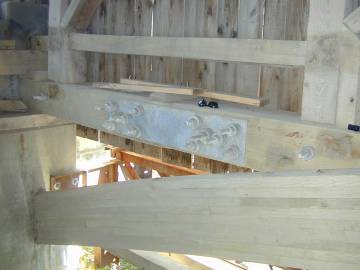
|
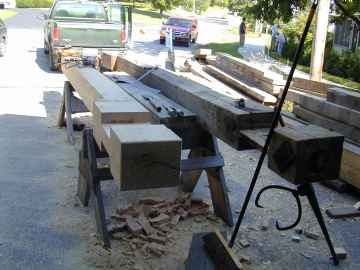
|
| The large metal plate on the upstream chord is a splice installed
by the State in the 1980s. This view also details one of the laminated arches at the west
abutment. |
The new and the old -- The kingpost on the right, part of the original construction, was
lap-cut to fit between the lower chord-members secured only by one bolt. The original chords
were not lapped to provide shoulders to lock the kingposts in place. |
Today, there are two large arches between the lanes that rise nearly to the ridge pole. A smaller arch rises to the eaves on each side. The center arches, consisting of a lamination of ten three-by six-inch planks, are bolted to both sides of a central multiple-kingpost truss. The outer arches are a lamination of nine three-by six-inch planks each bolted to the inside of a multiple-king post truss. There is no longer any evidence of the original segmented timber arches.
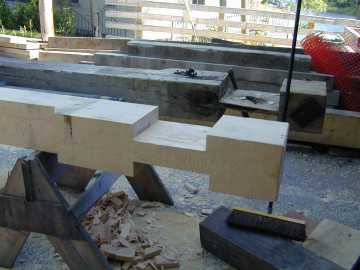
|
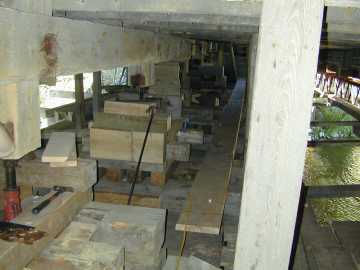
|
| A close-up of the kingposts, new vs. the original. The original
lap-cut left very little material where the post passes between the chord-members. |
A view of the center chord system. The truss chord members here are being reworked to
provide needed shouldering for the kingposts. The knob-ends of two kingposts can be seen
here. |
Besides being on the National Register of Historic Places, the Middlebury town plan identifies the bridge as a Scenic Roads Resource, giving it additional preservation status. The Town of Weybridge was awarded a grant to fund the pedestrian bridge beside the covered bridge.
The Pulp Mill Bridge was named for a wood-pulp mill that operated nearby. It is located on Weybridge Road on the Weybridge-Middlebury town line and is maintained by both towns.
 Joe Nelson, P.O Box 267, Jericho, VT 05465-0267, jcnelson@together.net
Joe Nelson, P.O Box 267, Jericho, VT 05465-0267, jcnelson@together.netNo part of this web site may be reproduced without the written permission of Joseph C.
Nelson
This file posted July 15, 2002, revised September 18, 2002